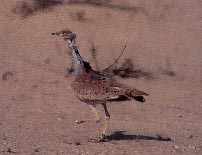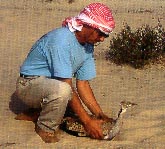Text by Theri Bailey and Dr. Fred Launay
Pictures by O.Combreau and Fred Launay
 People have always speculated where the Asian houbara bustard (Chlamydotis undulata macqueenii) , the favoured prey of Arab falconers, migrates from to reach the Arabian peninsula each winter. From mere curiosity and speculation, the need to piece together a more comprehensive picture of the houbara bustards' movements has become essential due to the continued decline in the houbara's numbers. This decline is believed to be as a result of destruction of their wintering and breeding habitat, over trapping and over hunting. Now, pioneering work by researchers from the Abu Dhabi based, National Avian Research Center (NARC), has begun to unravel the mystery of the this species' migration routes. Using sophisticated satellite tracking techniques, NARC has ensured that the United Arab Emirates (UAE) is the first country in the world to have tracked houbara bustard, both on their northerly and southerly migrations. Their results are being put to good use for conservation.
People have always speculated where the Asian houbara bustard (Chlamydotis undulata macqueenii) , the favoured prey of Arab falconers, migrates from to reach the Arabian peninsula each winter. From mere curiosity and speculation, the need to piece together a more comprehensive picture of the houbara bustards' movements has become essential due to the continued decline in the houbara's numbers. This decline is believed to be as a result of destruction of their wintering and breeding habitat, over trapping and over hunting. Now, pioneering work by researchers from the Abu Dhabi based, National Avian Research Center (NARC), has begun to unravel the mystery of the this species' migration routes. Using sophisticated satellite tracking techniques, NARC has ensured that the United Arab Emirates (UAE) is the first country in the world to have tracked houbara bustard, both on their northerly and southerly migrations. Their results are being put to good use for conservation.
The story unfolded on the 28th of February 1995 when a fine, male houbara bustard, weighing 1500g, was caught in the UAE. As houbara are notoriously difficult to trap on their wintering grounds, because they are few in number and not breeding, a falcon was specially prepared to catch the houbara. Its talons had plastic beads glued so their points and its beak was trimmed to prevent injury to the houbara when it was caught in the air. Once captured, a tiny satellite transmitter, weighing only 34g (of which only 3.5g of the weight was electronics and the rest a high rate lithium battery) was fitted onto its back. Looking at the transmitter it was difficult to imagine that this little device would really be light enough to be carried easily by a flying houbara for a couple of thousand kilometre and also powerful enough to send a signal to three satellites orbiting 1000kms from the surface of the earth which would relay the houbara's position, to within 5km of the true point, to a data processing computer in France. In addition, the manufacturers promised that the transmitter could be programmed to turn themselves on and off to conserve battery life and would relay the activity of the bird, the battery voltage and the ambient temperature. After only 40 minutes capture the researchers released the male houbara and hurried back to the comfort of their air-conditioned research station where they dialled into a modem link from Abu Dhabi to the data processing computer in France, and began to down load data on the progress of the houbara.
Observing the bird's progress electronically, the researchers were excited to see that after a few days apparently resting and feeding in a relatively small area of Abu Dhabi, the houbara took flight one night. They watched their computer screens as information on the bird's flight was continually updated. The bird traveled initially along the coast of the UAE and Oman and then across the Straits of Hormuz and into Iran where it stopped over for approximately three weeks. Just as the NARC researchers were beginning to think that the male would remain in Iran for the breeding season, the bird once more took off to fly to the border region of Turkmenistan, Kazakhstan and Uzbekhistan. Signals were received from this position until the battery life ended. By the end of this migratory journey, the male houbara had flown an impressive 2, 765 kilometres.
 This study led to an international agreement between the UAE and Kazakhstan which allowed NARC researchers to travel to Kazakhstan in the springs of both 1995 and 1996 during the houbara breeding season. Collaborating with researchers from the Institute of Zoology, in Almaty, the teams was able to capture nine houbara in the east of the country and five in the west.
This study led to an international agreement between the UAE and Kazakhstan which allowed NARC researchers to travel to Kazakhstan in the springs of both 1995 and 1996 during the houbara breeding season. Collaborating with researchers from the Institute of Zoology, in Almaty, the teams was able to capture nine houbara in the east of the country and five in the west.
Information received in 1995 and 1996 for all 14 satellite tagged houbara , indicated that they remained in Kazakhstan until the month of September at which point they started migrating south. What became clear from the data analysed in both years was that the houbara from the east and the houbara from the west of Kazakhstan take different migration routes and therefore end up on different wintering grounds. Before the battery life expired, fixtures for the eastern birds showed that four had moved into Afghanistan and one into Iran. Of the western houbara, three migrated to Iraq and one to western Iran. The short battery life of the transmitter is a disappointment to the NARC researchers and it is hoped that soon a battery will be developed to last for many months, preferably a year, so that researchers can track the same houbara both to and from their breeding grounds, before retrieving the transmitters.
There is still a great deal to learn and many mysteries to unravel concerning migrations of the houbara bustard. National Avian Research Center's researchers look forward to another year of satellite tagging houbara and observing, via data displayed on their computer screens, both northerly and southerly migration pathways. Results of this new mapping programme are certain to influence conservation measures for the Asian houbara bustard, helping to pinpoint breeding grounds, wintering grounds and stop-off points so that they can be effectively managed and protected. This technology based research brings hope that the words of the UAE President, H.H. Sheikh Zayed, quoted at the beginning of this article, will hold true in the future, as they have in the past.
| Subjects | Search
Arabian Wildlife. Volume 3, Number 2